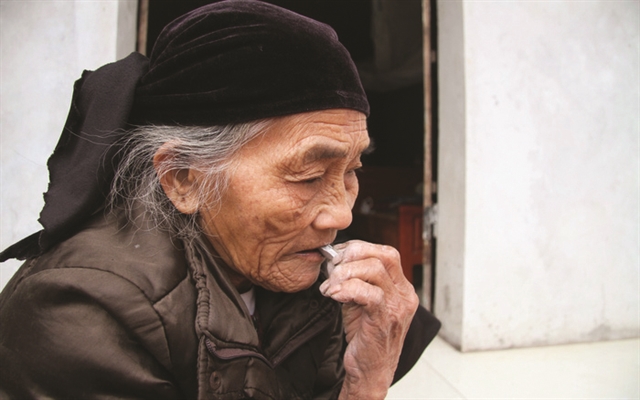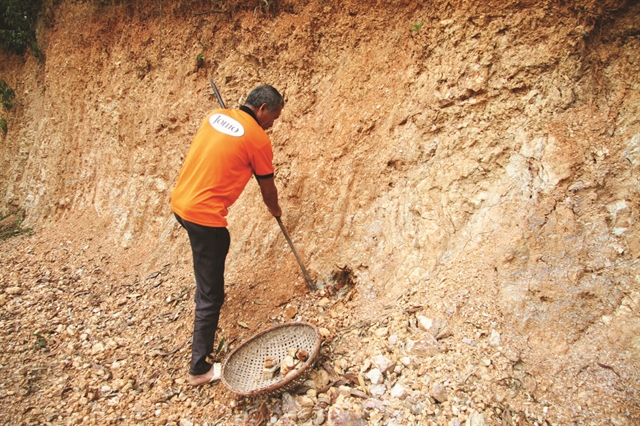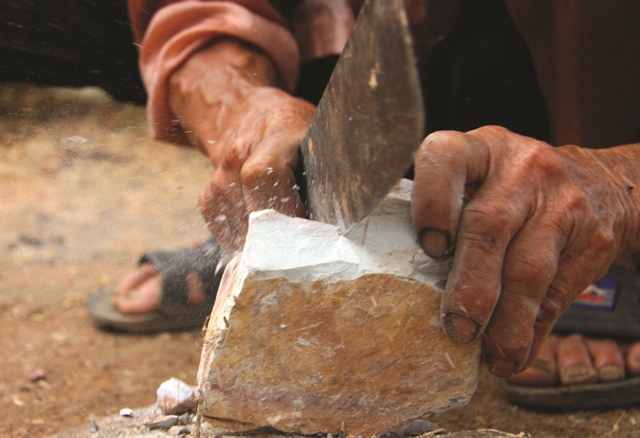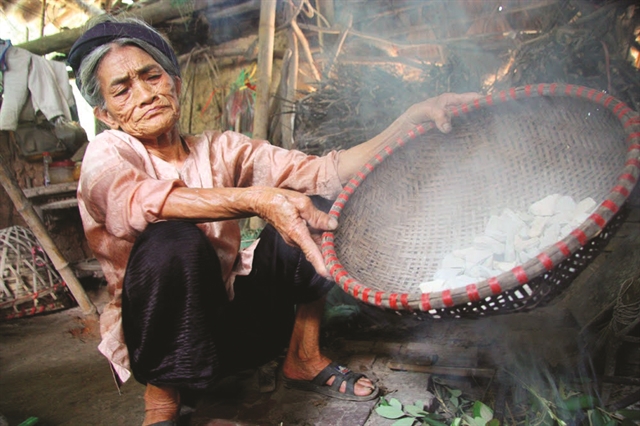 Life & Style
Life & Style

Though today’s youth no longer eats local clay, many elders living along Thống Nhất Street still say clay is their favourite snack.
Trần Hoàng Nam
It’s hard to imagine clay can be a delicacy or a kind of dessert.
But it’s nothing strange in Lập Thạch Town, Lập Thạch District in the northern province of Vĩnh Phúc.
Though today’s youth no longer eats local clay, many elders living along Thống Nhất Street still say clay is their favourite snack.
Elders in the area said they did not know how long the custom had existed. Many said they had seen their grandparents and parents eating clay when they were younger.

|
| Khổng Thị Biện is among the last elders in the locality eating smoked clay as a habit. — Photo phunuvietnam.vn |
In their early 90s, couple Khổng Văn Loa and Khổng Thị Biện are still smart and sharp minded.
Biện said she was born on the Lô River Delta (now Lô River District) and she remembers old people in her family putting clay in their mouths and chewing it like candy. Since then, she imitated them and has eaten the clay for decades.
This kind of clay on the Lô River Delta then almost disappeared. Some people found the same clay in the area around Thống Nhất Street.
“This clay tastes delicious,” Biện said, chewing a piece.
“Not all kinds of soil can be eaten. We only eat this kind of clay in this area.”
“I’m addicted to it. I must eat some every day otherwise I’ll not feel good, like a tobacco addict,” she said.
The baked clay is soft, a little sweet with some fragrance.
Many locals said eating the clay is like eating dry provisions for soldiers, but they do not feel thirsty like when eating the latter.

|
| The clay is found under the surface. — Photo dantri.vn |
Biện said the clay is found under the soil surface. Digging down, one can find white areas of soil that look like pieces of chalk, which is the edible clay.
The edible clay is in two colours: milky white and faint blue. People with strong teeth can eat the faint blue clay while old people can eat only the white variety.
The blue clay is harder to chew, locals said.
The clay is then rinsed and dried. Big chunks are then cut into small pieces like candies.
Locals then burn leaves of sim (Rhodomyrtus tomentosa), a kind of bush, and smoke the clay on the fire. The fragrance of the burnt leaves is absorbed into the clay, creating a unique flavour.
Good for health?
Seniors citizens in the village said eating clay was a custom, but some of them were convinced the snack had medicinal properties.
The clay is used as a kind of dessert that villagers would offer when they visited one another’s home.

|
| Special clay. — Photo dantri.vn |
Some 20-30 years ago, this kind of clay was sold at local markets. Stalls of clay were placed next to those selling vegetables and meat.
Lập Thạch used to be the area providing the clay to various neighbouring areas like Tam Dương, Vĩnh Tường, Lâm Thao, Phù Ninh (in Phú Thọ Province), and further in Hà Giang and Tuyên Quang provinces.
Biện said her family dug up clay from an area behind her garden. The clay is still available now. Biện said Vietnamese and South Korean experts have done various studies but she has not been informed of the results so far.
“I now have only some 100kg of clay to eat,” she said. “The hill has been broken by my offspring to build their houses.”
Biện said when she was young, there were not many snacks like today. Thus, from children to old people, every one ate clay as a kind of snack, especially pregnant women.
“I sometimes sold a whole basket of clay at the market,” she said.
According to Lê Văn Hữu, a local official in the district, in the 1970s, many people ate the clay.
He also remembered seeing the clay sold at local markets.
“This kind of clay can no longer be found anywhere here except the hill behind Mrs Biện’s garden,” he said.
He said there was no evidence the clay is good for your health.

|
| The clay is smoked over a fire made from leaves of Rhodomyrtus tomentosa. — Photo dantri.vn |
The custom dates back to ancient times, when soil was a gift to be presented at engagement ceremonies.
Lĩnh Nam Chích Quái, a record of extraordinary occurrences in ancient Việt Nam, says that marriages in ancient times were either blessed or not depending entirely on the piece of soil presented.
The soil mentioned in the book might be the soil that Vietnamese people ate a few decades ago.
Some foreign researchers including G. Dumoutier in the late 19th century and early 20th century did research on the custom.
Dumoutier writes in his 1908 essay about the people of Tonkin that soil eating was popular in Sơn Tây, Hà Đông (present-day Hà Tây), Nam Định and Thái Bình provinces.
He writes that some foreigners became curious about the habit and took soil samples to Paris for analysis, and it was discovered that the soil had a number of mineral properties such as iron, calcium and several acids.
It was also determined that the indigenous people who traditionally ate the clay regarded it as a type of candy, not a savoury food.
The custom of clay eating still persists in some areas in the northern mountainous provinces of Điện Biên, Sơn La, Lào Cai and Yên Bái, according to the writer.
The practice of soil eating is related to customs from the era of the Hùng Kings (circa 2879-258BC) that highlight the offering of a piece of soil as a pre-requisite for a successful marriage.
"Vĩnh Phúc is the native land of the founders of this country, the Hùng kings, it may be that eating soil is a way for Vĩnh Phúc residents to keep their age-old practice intact," said geologist Võ Công Nghiệp.
“When old locals like me and my husband die, the custom may no longer exist,” Biện added. “Today, there are too many kinds of better snacks.” — VNS




